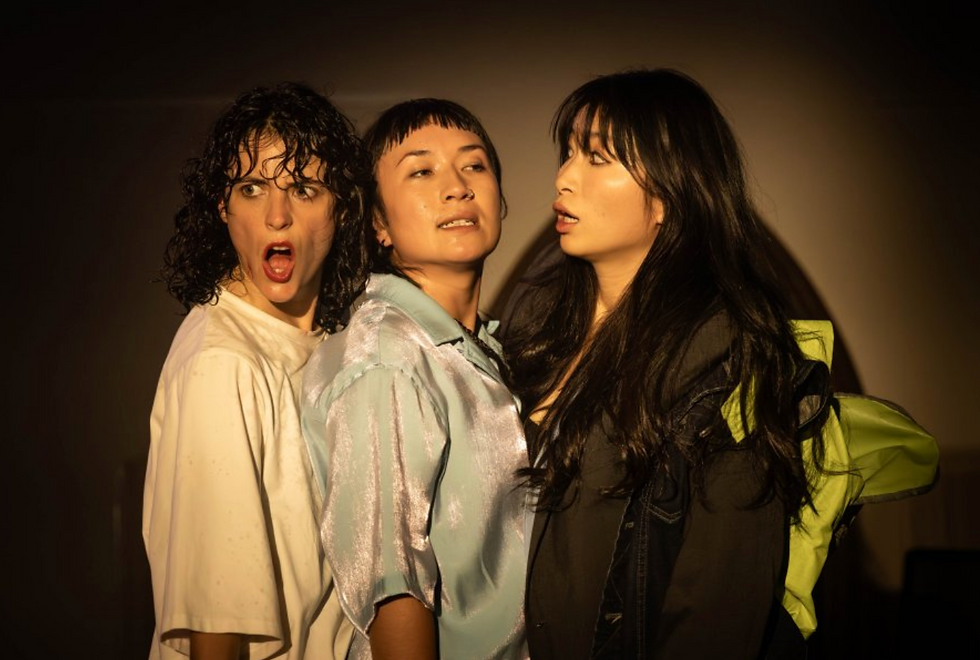Review: Cut at Fortyfivedownstairs
- Theatre Travels

- Mar 20, 2023
- 3 min read
Review by Naomi Cardwell.
Catching a play at fortyfivedownstairs unfolds like a scaled-down encounter with the city of Melbourne itself. We begin in a space tiled and echoing like an old-fashioned subway terminal, from which we descend into a light-filled gallery packed with cool people and fabulous art. Suddenly, a bell rings, and everyone is rushing away, spilling down yet more stairs into a cavernous basement space shrouded by thick black curtains. As Cut commences, actress Christina McLachlan asks the audience to switch off their mobile phones - not put them on flight mode, she clarifies, with a toothy, slightly sinister smile: turn them off. The play must begin in darkness.
Thrumming with menace and foreboding, Cut is a solo performance which follows an unnamed flight attendant who is stalked by an obsessed passenger. As the deeply unreliable narrator’s account advances, the thriller turns in on itself and reality begins to warp.
The audience is split in two by a jutting, catwalk-like stage which slices through the centre of the room. With its narrow stainless-steel floor lit by strips of light, the stage takes on the form of a razor’s edge, the claustrophobic centre aisle in an aeroplane, a baggage inspection counter, and a subway platform ripe for intrusive thoughts.
The emphasis on darkness at Cut’s beginning pays off: the play’s lighting design by Clare Springett is pure poetry, and easily the best I’ve seen in years. The lights falter as the protagonist’s train shudders through the dark, they recede to queasy blue exit markings as she serves meals to aeroplane passengers (“Chicken or beef?”) and open out into an intense, sepia sunshine during a profoundly disturbing flashback sequence set at the beach.
The set itself, by Bethany J Fellows, is equally ingenious. All the colours of the lighting glare back at us in the sheen of the sterile metal stage. Overhead, a ceiling of the same material hangs low, offering flashes of a distorted and uncanny reflection of the action underneath, underscoring the play’s meditation on fear, doubt and credulity. A standout scene is staged behind the aircraft’s pleated galley curtains, with only McLachlan’s feet visible as two flight attendants whisper together. McLachlan’s performance is electric, as she generates suspense by oscillating between striking stillness and shuddering, fear-driven movement. Her tableaus - of the flight attendant in motion with her carry-on luggage on a windy day, and later reeling in horror through successive shocks, will stay with me for days.
Director Laurence Strangio’s use of space ratchets up the tension of the piece, reading predator and prey into the narrow platform as McLachlan paces relentlessly in stockinged feet. Sound designer Darius Kedros seamlessly alters McLachlan’s voice to reflect her character’s varying lucidity and cruel, dark digressions, with a rich auditory atmosphere full of maddening little sounds that move, tease and vanish around the room.
Written by Duncan Graham, Cut was first staged at Sydney’s Belvoir Street Theatre in 2011, followed by a stint at the Adelaide Fringe festival in 2015. Post-#metoo and delayed by Covid-19, its treatment in Melbourne by Talking Walls has polished the piece into a smart, chilling thriller which sustains our fight/flight response for the full sixty-minute duration.
Strangio’s emphasis on ambiguity cleverly captures the relentlessly rising and falling terror that hounds women whenever we walk alone in the dark: from the labour of justified and necessary vigilance to its habit of morphing in the dark into gnawing paranoia. As Cut comes to its unsettling conclusion, the audience spills up out of the theatre into the night, disbursing into Flinders Lane, consumed in debate.

Image Supplied




